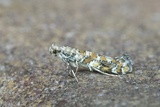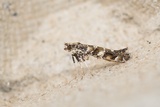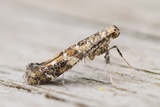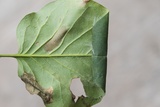Gracillaria syringella (Fabricius, 1794) Species
Last modified: Dec. 10, 2025, 2:02 p.m.
A common species throughout Belgium, sometimes causing damage to hedges curling the leaves and turning them brownish.
Details
- Classification
- Family: Gracillariidae > Subfamily: Gracillariinae > Tribus: Gracillariini > Genus: Gracillaria > Species: Gracillaria syringella
- Vernacular names
- Seringensteltmot (NL), Common slender (EN), Flieder-Blatttütenfalter (DE)
- First mention in Belgium
- De Fré Ch. 1858. Catalogue des Microlépidoptères de la Belgique. — Annales de la Société entomologique belge 2: 45–162. On page 146. view page
- Status
-
Native
Distribution
Mine
The first instars make a rather broad, but inconspicuous, gallery at the underside of the leaf, which later on turns into a brownish blotch.
See also gracillariidae.net and bladmineerders.be.
Cocoon/pupa
A whitish silken cocoon on the underside of the leaf.
Bionomics
Most of the time, ten or more eggs are deposited together near the midrib of a leaf. The first instars each construct their initial mine in the same leaf. Later on, the leaf starts to contort and the tissue turns brownish. The free-living instars leave the mine and spin a downwards rolled leaf in which they still continue feeding together.
Pupation individually in a white cocoon which is spun on the underside of a leaf, most of the time dropping to the ground during autumn.
The adults are active at dusk and come to light.
Flight periods
The adults fly in two generations a year from late April to mid-June and again from late June to late August.
Observed on
- Host plant (species):
- Syringa vulgaris, Ligustrum vulgare and Fraxinus excelsior
- Host plant (genera):
- Ligustrum, Fraxinus and Syringa
The larvae feed on: Ligustrum, Fraxinus and Syringa. The species sometimes also mines planted bushes or trees, mainly of the family Caprifoliaceae, but in these cases, the development is not complete.
Habitat
Parks, gardens, forest edges or clearings, also lonely growing Fraxinus trees.




